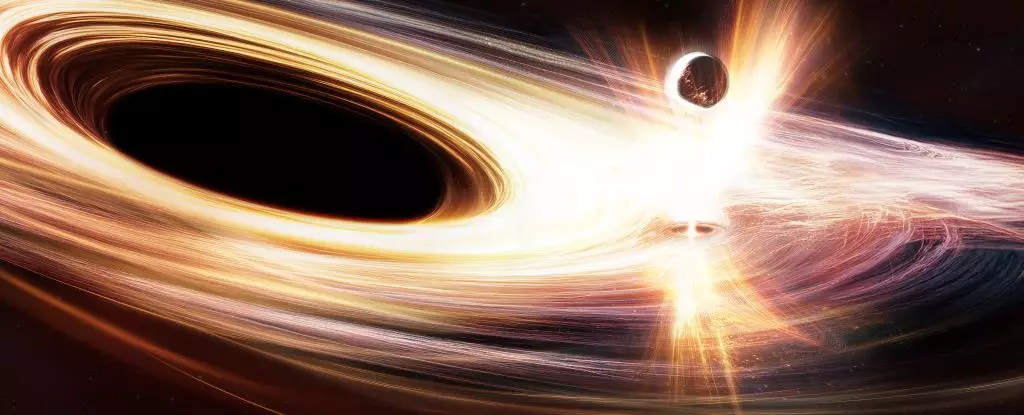In the vast cosmos, black holes have long tantalized astronomers and astrophysicists alike with their gravity-defying phenomena. Recently, a supermassive black hole—dubbed Ansky—located approximately 300 million light-years away at the center of galaxy SDSS1335+0728, has sparked widespread intrigue and bewilderment in the scientific community. Since 2019, Ansky has transformed from a silent giant into an active entity, unleashing unprecedented bursts of energy that are challenging long-held perceptions of black hole behavior. The perplexing character of Ansky serves as a reminder that the richness of the universe often defies expectations.
The Astounding Activity of Ansky
Astrophysicists have consistently categorized black holes as objects alternating between states of quiescence and violent activity. Conventional wisdom often depicts them as cosmic vacuum cleaners, perpetually devouring surrounding material. However, Ansky shatters these simplistic notions. Unlike typical supermassive black holes, whose eruptions are common yet predictable, Ansky’s bursts of X-rays are ten times longer and more luminous than previously observed. Astrophysicist Joheen Chakraborty from MIT notes that each eruption releases a staggering hundred times more energy than regular quasi-periodic eruptions. The distinct cadence of Ansky’s activity, occurring roughly every 4.5 days, pushes the boundaries of existing astrophysical models, demanding a deeper understanding of these celestial phenomena.
Understanding Quiescence and Activity
The dual nature of black holes—active and dormant—highlights their complex existence. While the black hole situated at the core of our own Milky Way galaxy remains relatively quiescent, Ansky is a testament to the potential for dramatic transitions between states. This phenomenon is not merely a display of chaos but represents essential mechanics in the grand tapestry of galactic evolution. Supermassive black holes, in their active phase, contribute significantly to the formation of galaxies and the star-speckled environments that surround them. The transition into such an active state, as remarkably observed in Ansky, offers critical insights into black hole dynamics and their influence on galactic structures.
The Shift to Activation
Ansky’s shift to an active state marks a pivotal moment in observational astronomy. For the first time, astronomers witnessed a black hole ‘waking up’ from a prolonged repose, providing a unique window into the processes underlying black hole behavior. Under the leadership of astronomer Lorena Hernández-García from the Millennium Institute of Astrophysics, ongoing observations of Ansky since its initial activation in 2019 reveal only a handful of eruptions. These recordings confront foundational understandings of black hole activity. Such unprecedented access to Ansky’s transitional phases yields the potential for groundbreaking discoveries that could unlock further mysteries of dark matter.
The Light of Activity and the Question of Origin
While black holes themselves are enveloped in darkness, their energetic outbursts paint a mesmerizing picture. The gravitational forces at play in Ansky’s vicinity create extreme conditions, igniting the surrounding material into a radiant display. Traditionally, it has been theorized that quasi-periodic eruptions occur due to nearby celestial objects spiraling precariously close and becoming ensnared in a black hole’s gravitational web. However, the nature of Ansky’s illumination defies expectations. Displayed across multiple wavelengths, from infrared to X-rays, the brightness and duration of its eruptions raise questions that current models cannot easily answer.
Shifting Paradigms: New Insights on Gravitational Waves
As researchers grapple with Ansky’s peculiar behavior, they are also considering potential connections to gravitational waves, adding another layer of complexity. According to ESA astronomer Erwan Quintin, Ansky’s eruptions may be linked to these ripples in spacetime, which could be detected by future missions, such as LISA. The interplay between black hole eruptions and gravitational waves could reshape our understanding of these formidable entities and the interstellar phenomena surrounding them.
The Imperative for Further Exploration
Ansky’s remarkable activity illustrates more than just an astronomical curiosity; it is an urgent call to arms for scientists. The need for continuous observation and refined theoretical models is growing, as the eruptions challenge prevailing hypotheses about black holes’ life cycles. Understanding this supermassive black hole’s behaviors could enlighten our grasp of cosmic evolution and inspire future research that delves into the unexplored depths of the universe. Our journey into the enigmatic world of black holes is only just beginning, and Ansky is leading the charge into uncharted territory that will undoubtedly redefine our cosmic narratives.


Leave a Reply